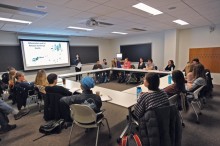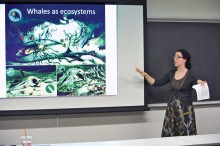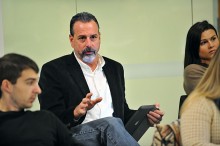Earth under the microscope
Senior seminar explores our impact on the planet from every angle

It’s hard to say. It’s tricky to spell. Few people have even heard of the word.
But it could be one of the most significant descriptors in any language, considering that the future of the globe may depend on how well people understand it, are willing to engage in discussion about it, and can critically think about their own role in issues raised by the concept.
Coined in the early 1980s, Anthropocene is a geologic designation that suggests for the first time that human beings—and not just natural forces—are shaping the earth’s ecosystem through business practices and lifestyles that contribute to everything from global warming to habitat destruction and health pandemics.
In a world just starting to acknowledge the implications, Wheaton College students are at the leading edge of inquiry, thanks to a new BIO 401 Senior Seminar course, “Enter the Anthropocene,” offered last fall.
The discussion-based course created by Associate Professor of Biology Shawn McCafferty was a novel rendering of BIO 401. The seminar—a “capstone” course designed to give soon-to-be graduates the chance to apply knowledge gained in pursuit of their major to a culminating Wheaton experience—is offered annually and is taught on a rotating basis among biology faculty members. Professors come up with their own themes for the seminar.
For the first time, BIO 401 was presented through cross-curricular perspectives from 11 faculty members across divisions. Students spent the semester looking beyond the sciences—to religion, philosophy, anthropology and art, among other disciplines—to consider mankind’s role in causing, and subsequently addressing, environmental issues ranging from global climate change and pollution to the mass extinction of plant and animal species.
McCafferty says he came up with the idea for the collaborative course to meet his students’ broad range of interests and backgrounds, but also to highlight a topic that is garnering increasing attention in academic and policy circles alike.
Human beings already are straining the planet’s resources, and challenges, along with a fair share of soul-searching, are mounting.

When Valerie Gikas ’14, an environmental science major, considers this, she worries about how the crowded planet will survive, given the seemingly insatiable and growing demand for materials and resources and the resulting stress on the environment.
“How do we approach this problem?” she wonders. “Is it more beneficial to start at an individual level or take a political approach? Can it be solved through activism, or through educating young people about the environment?”
It’s not the typical concern of most college students, but it was front and center last fall in a classroom in the Mars Center for Science and Technology, where 21 students tackled some big questions.
“Are we living in the Anthropocene?”
“What evidence have we collected to document our impact on the earth?”
“What are the next steps we can take? What are our options, and do we have moral obligations?”
“What insights do other disciplines offer, from the humanities as well as from science?”
Gikas and her classmates were required to reach far and wide across disciplines to seek answers that could have global implications.
“It’s easier to solve the problem when you get the different perspectives,” she says. “You’re tackling more of it when you come at it that way.”
Biology major Melissa Darnley ’14 agrees: “We’re living in a world now where you can’t stay in your own little niche. You have several other niches, even within science, that you need to come into contact with every day. If you don’t understand where other people are coming from or what their train of thought is, you can’t connect with them and come up with a solution to a problem. There’s a wide range of people on the earth with different opinions and different mindsets. With that comes the need to have everybody on board to make changes.”
For many of the students, the very word—Anthropocene—was an unfamiliar concept.
“I had heard the name floating around, but never really captured it in a concrete way,” says Carolyn Decker ’14, an environmental science major. “We did spend quite a bit of time at the beginning of the seminar asking, ‘What exactly are we talking about here? What does it mean and how does it apply in all of these interdisciplinary ways?’”
Decker and her classmates explored the concept through research papers on varied topics, which they wrote by consulting peer-reviewed scientific research, and then made oral presentations.
Gikas explored the impact of consumerism on the planet in her research; Elizabeth Meyer ’14 (pictured on page 31), a biology major, wrote about how commercial whaling affects marine ecosystems; and environmental science major Rose Harris ’14 considered whether our attempt to replicate nature in our living and office spaces is distancing us from real nature and interest in environmental concerns.
In their papers, students weren’t required to propose solutions to their high-stakes topics, but many did.

Up to 95 percent of road mortalities are amphibians—more than other vertebrate animals, according to her findings. “Amphibians are a bellwether for ecosystem health,” she says. “They’re important in a lot of ways. They’re a food source for a lot of people, and they’re one of the main organisms that eat mosquitoes.”
Regardless of their majors and academic backgrounds, students found themselves immersed in challenges that spilled across the educational spectrum. As Stephen Das ’14, a biology major, notes: “It showed us how everything we’re learning can be used to help understand the world around us.”
Faculty across divisions contributed to the debate by hosting discussions with the class on topics they thought were relevant to the theme. Presenters included Peter Coco, Library and Information Services digital learning liaison, and professors Jani Benoit (chemistry), Jonathan Brumberg-Kraus (religion), Teresa Celada (philosophy), Geoffrey Collins (geology), Barbara Darling-Smith (religion), Jason Goodman (physics), John Kricher (biology), Scott Shumway (biology), Josh Stenger (film studies and English), M. Gabriela Torres (anthropology) and Russell Williams (economics).
Students also guided discussions. In addition, they created and hosted a blog based on the coursework and classroom discussions. McCafferty even asked bloggers to submit the title of a song or lyrics to form a “Playlist for the Anthropocene.” Entries included “It’s the End of the World as We Know It” by R.E.M., “Bad Moon Rising” by Creedence Clearwater Revival,” and McCafferty’s own submission, Samuel Barber’s melancholy Adagio for Strings. (“If a video detailing man’s environmental transgressions played in my head, this would be the soundtrack,” he says.)
McCafferty’s approach makes good on calls from the international Rachel Carson Center for Environment and Society, which says the Anthropocene “demands transdisciplinarity … and (it) challenges established demarcation lines within academia.”
A 2013 report by the center, which works to strengthen the role of the humanities in current political and scientific debates about the environment, shows that a lively debate among international thought leaders is underway about the philosophical, legal, aesthetic, pedagogical and cultural implications of the era at hand. The center, based in Munich, Germany, holds ongoing colloquia, conferences and workshops on the environment.
“Clearly, the idea of humanity’s overwhelming impact on the planet has as much relevance to the ecology-minded as it would for the cellular- and molecular-minded,” McCafferty says. “Not only does the idea of the Anthropocene cover what will arguably be some of the most important issues our students will face as they get older, it is ripe for cross-curricular exploration.
“As scientists, we’re more prepared to think about the ideas and the concepts behind global climate change and ecosystem disruptions,” McCafferty adds. “But we need to go back and ask, ‘How does this come back and impact us as humans?’ This is challenging students to think in different ways. To me, this is what a liberal arts education is all about. It’s going beyond the cold, empirical scientific approach.”
When the professor sent a campus-wide email soliciting speakers for the seminar, the response was so robust that he couldn’t include everybody; 11 guest speakers addressed the class.
One of those answering McCafferty’s call was Assistant Professor of Religion Barbara Darling-Smith, who teaches a course called “Religion and Ecology.”
While faith and science have long experienced a troubled coexistence, the seminar offered an open— and welcoming—floor.
“The most important thing religion brings to the discussion is a sense of hopefulness,” Darling-Smith says, echoing the message she shared with students during her presentation, titled “Can Religion Help Humans Be at Home on This Planet?”
“Religions can provide community and solidarity, which is important in feeling as though one’s own efforts are making a difference,” she says. “Religions also all have some sense of the transcendent, which can inspire our own efforts to work for positive change with regard to the negative effects of human activity on the environment.
M. Gabriela Torres, associate professor of anthropology, in her presentation, “Favelas of Rio de Janeiro: A Discussion on How Inequality Shapes Environments and Cultures,” considered the Anthropocene by looking at the economics of privilege and scarcity in Brazilian slums known as favelas. She focused on how humans react to environmental constraints born of income inequality.
“The students were able to see how cultural practices are not just things that are because they are, but they’re shaped by environments,” Torres says. “They were also able to see that we shape our environments by our cultural practices. It’s not a simple process in which we shape the environment, or the environment shapes us. It goes both ways.”
Torres adds that the liberal arts framing of the Anthropocene makes students very agile thinkers. “If you think about human existence, it doesn’t occur in the neat disciplinary categorizations that we’d like to give them. Humans are extremely complex, and we can’t get a picture of humanity from any one of these disciplines.”
Not everyone is ready to anoint the Anthropocene a new geologic epoch, however. Some in the scientific community point to the lack of stratigraphic evidence, or changes in rock layers, as a lack of definitive proof.
“I can argue it either way,” says geology professor Geoff Collins, a planetary scientist who was one of the featured seminar speakers. “There are some reasons to think that humans may have a large, lasting impact, and there are other reasons to think that much of our impact will be erased very quickly, geologically speaking. An informative thought experiment is to contemplate the question: ‘If dinosaurs had a technological civilization for several centuries, what evidence would be left today, sixty-five million years later?’”
What’s not disputed is that humans will continue to exert influence—for better or for worse—for years to come. There is no shortage of ways to consider such an impact.
And for students like Das, the overriding question to keep asking is: “What kind of planet do we want to leave for the next generation?”
